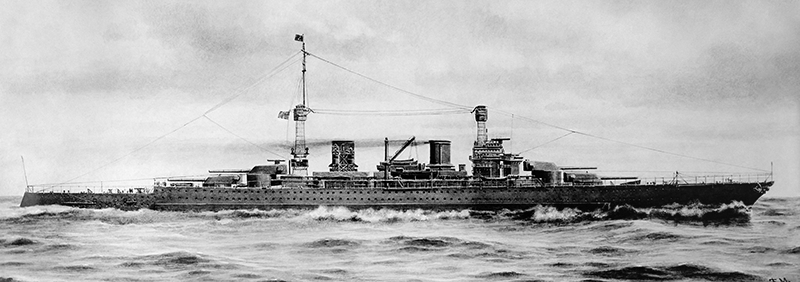

Lexington (1920 design)
| No | Name | Yard No | Builder | Laid down | Launched | Comm | Fate |
| CC1 | Lexington | 300 | Fore River, Quincy | 8.1.1921 | 30.10.1925 | --- // 14.12.1927 | built as aircraft carrier from 7.1922 |
| CC2 | Constellation | 215 | Newport News | 18.8.1920 | --- | --- | cancelled 17.8.1923 |
| CC3 | Saratoga | 199 | New York SB, Camden | 25.9.1920 | 7.4.1925 | --- // 16.11.1927 | built as aircraft carrier from 7.1922 |
| CC4 | Ranger | 216 | Newport News | 23.6.1921 | --- | --- | cancelled 17.8.1923 |
| CC5 | Constitution | Philadelphia N Yd | 25.9.1920 | --- | --- | cancelled 17.8.1923 | |
| CC6 | United States | Philadelphia N Yd | 25.9.1920 | --- | --- | cancelled 17.8.1923 |
|
Displacement normal, t |
43500 |
|
Displacement full, t |
44638 |
|
Length, m |
259.1 wl 266.5 oa |
|
Breadth, m |
32.1 |
|
Draught, m |
9.50 |
|
No of shafts |
4 |
|
Machinery |
4 electric motors, 4 General Electric turbo-generators, 16 Yarrow boilers |
|
Power, h. p. |
180000 |
|
Max speed, kts |
33.5 |
|
Fuel, t |
oil |
| Endurance, nm(kts) | |
|
Armour, mm |
belt: 178, barbettes: 229 - 127, turrets: 280 face, 152 sides, CT: 305 |
|
Armament |
4 x 2 - 406/50 Mk 2, 16 x 1 - 152/53 Mk 12, 4 x 1 - 76/52 Mk 10, 8 - 533 TT (beam) |
|
Complement |
1297 |
Project history: The General Board considered building battlecruisers in 1912, to counter the four Japanese Kongos, but it withdrew them from its proposed programme because Congress was unwilling to buy enough battleships, which it considered a more urgent requirement. The ships contemplated at that time would have been relatively heavily armoured, and as such were much closer to fast battleships than to the 'battle scouts' approved in 1916. The Lexingtons were ordered as part of the large 1916 programme, as part of a scouting force to support a large battlefleet. They were, in effect, scaled up from a series of designs for cruisers displacing about 10000 to 14000 tons, and so would have been much more lightly built than contemporary US battleships. The original 34800t design showed a battery of 10x356mm/50 guns, in two twin and two triple turrets: the shift to 406mm weapons was not made until 1917. Design requirements included provision for aircraft, which probably explains the break in the main deck right aft: when these ships were designed, the only US catapult was the fixed straight-deck type in the old armoured cruisers. Although trainable catapults were designed immediately after World War One, no later sketches show them in the final design.
These very large ships originated as battle scouts, as ships powerful enough to press home reconnaissance in the face of enemy battlecruisers. They were conceived as part of a 35kt scouting force, other elements of which were the flush-deck destroyers and the Omaha class cruisers. The original design was complicated by the relatively limited steam output of existing boilers: there was not enough space below the armoured deck for the 24 units needed to make 180000shp. Hence the unusual design initially adopted, in which half the boilers were above the protective deck. It would have been adopted, had not all American capital ship construction been suspended in favour of merchant ship and ASW programmes in 1917. The final, more conventional, boiler arrangement was adopted because, with the appearance of small-tube boilers, their number could be reduced to 16, and all could be fitted below the armour deck.
The final version of the design owes much to US reactions to HMS Hood, even though it was still very lightly armoured, and so still reflected the original operational concept. The Bureau of Ordnance argued, moreover, that on the basis of British analysis of Jutland, the loss of the battlecruisers had been due, not to their lack of armour, but to their poor anti-flash protection: the battle, then, did not imply that more armour was needed, but rather that better magazine arrangements were in order. The choice of a sloping belt owed much to British practice, as (probably) did the decision to provide four above water TT to supplement the four underwater ones.
All six were cancelled under the Washington Treaty, two being completed as large aircraft carriers. However, it appears that they were considered obsolescent even before the negotiations, since early in 1921 there were studies of conversions to carriers, and also of the use of material collected for the Ranger to build a carrier designed as such from the keel up.
Two ships were completed as aircraft carriers.
Ship protection: Main 178mm belt was inclined outside at 12° and protected two deck level space, two deck levels above them were protected by upper 57mm belt inclined inside at 10°. Turrets and barbettes had up to 356mm thick armour, CT had 406mm sides. Underwater protection included two 19mm longitudinal bulkheads from each side.

© Navypedia, 2020